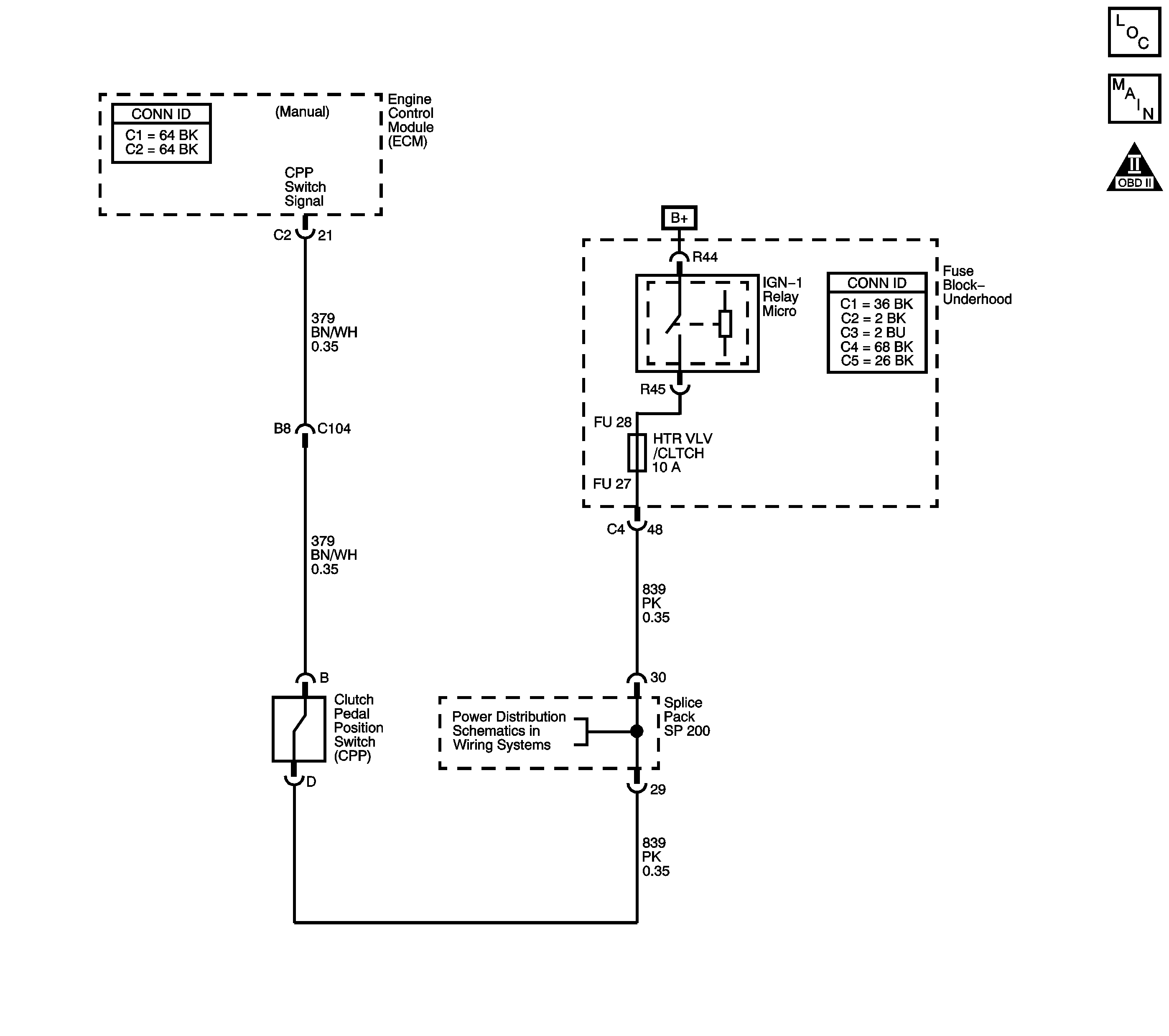
Circuit Description
The clutch switch is a normally closed switch, clutch pedal released. The engine control module (ECM) detects an ignition voltage on the clutch switch circuit when the clutch switch is closed. The ECM detects 0 volts on the clutch switch circuit when the clutch switch is open, clutch pedal depressed.
When the ECM detects a large number of gear changes without detecting a clutch switch transition, DTC P0833 sets. DTC P0833 is a type C DTC.
Conditions for Running the DTC
| • | No VSS DTCs. |
| • | The vehicle speed is greater than 15 km/h (9 mph). |
| • | The brake switch remains released. |
Conditions for Setting the DTC
| • | The ECM must detect 20 or more gear changes with less than 6 clutch pedal transitions. |
| • | Time between gear changes must be 4 seconds or greater. |
Action Taken When the DTC Sets
| • | The ECM stores the DTC information into memory when the diagnostic runs and fails. |
| • | The malfunction indicator lamp (MIL) will not illuminate. |
| • | The ECM records the operating conditions at the time the diagnostic fails. The ECM stores this information in the Failure Records. |
Conditions for Clearing the MIL/DTC
| • | The ECM turns OFF the SVS lamp when the condition no longer exists. |
| • | A scan tool can clear the DTC. |
| • | The ECM clears the DTC from ECM history if the vehicle completes 40 warm-up cycles without a non-emission-related diagnostic fault occurring. |
| • | The ECM cancels the DTC default actions when the fault no longer exists and the DTC passes. |
Test Description
The number below refers to the step number on the diagnostic table.
-
This test confirms if the scan tool is receiving a clutch switch position signal.
-
This step inspects the clutch pedal connector and adjustment.
Step | Action | Values | Yes | No |
|---|---|---|---|---|
1 | Did you perform the Diagnostic System Check - Engine Controls? | -- | Go to Step 2 | Go to Diagnostic System Check - Engine Controls in Engine Controls - 2.6L and 3.2L |
Does the scan tool indicate a change in state when the clutch pedal is either applied or released? | -- | Go to Intermittent Conditions in Engine Controls - 2.6L and 3.2L | Go to Step 3 | |
Inspect the adjustment of the clutch pedal position switch and the connector. Does the clutch switch require adjustment or the connector require service? | -- | Go to Step 11 | Go to Step 4 | |
4 | Inspect the ABS fuse for an open. Refer to Circuit Protection - Fuses in Wiring Systems. Is the ABS fuse open? | -- | Go to Step 9 | Go to Step 5 |
5 | Using a DMM, measure voltage at the brake fuse. Does the DMM indicate the specified value? | B+ | Go to Step 6 | Go to Step 12 |
6 |
Does the DMM indicate the specified value? | B+ | Go to Step 7 | Go to Step 13 |
7 |
Does the scan tool display that the clutch is applying and releasing? | -- | Go to Step 15 | Go to Step 8 |
8 |
Did you find a short to voltage, high resistance or an open on the clutch pedal position switch signal circuit? | -- | Go to Step 14 | Go to Step 16 |
9 |
Is the ignition 3 voltage circuit grounded? | -- | Go to Step 13 | Go to Step 10 |
10 | Using a DMM, test for a short to ground on the clutch pedal position switch signal circuit at the switch connector. Is the clutch pedal position switch signal circuit grounded? | -- | Go to Step 14 | Go to Step 15 |
11 | Adjust the clutch pedal position switch, or repair the connector as necessary. Did you complete the repair? | -- | Go to Step 17 | -- |
12 | Repair the power distribution circuit to the brake fuse. Did you complete the repair? | -- | Go to Step 17 | -- |
13 | Repair the open, high resistance or short to ground in the ignition 3 voltage circuit or a parallel circuit that uses the brake fuse. Did you complete the repair? | -- | Go to Step 17 | -- |
14 | Repair the open, high resistance or short to ground in the clutch pedal position switch signal circuit. Did you complete the repair? | -- | Go to Step 17 | -- |
15 | Replace the clutch pedal position switch. Refer to Clutch Pedal Position Switch Replacement in Clutch. Is the action complete? | -- | Go to Step 17 | -- |
16 | Replace the ECM. Refer to Engine Control Module Replacement in Engine Controls- 2.6L and 3.2L. Is the action complete? | -- | Go to Step 17 | -- |
17 |
Has the test run and passed? | -- | System OK | Go to Step 2 |
18 | With the scan tool, observe the stored information, capture info and DTC info. Does the scan tool display any DTCs that you have not diagnosed? | -- | Go to Diagnostic Trouble Code (DTC) List in Engine Controls - 2.6L and 3.2L | System OK |
